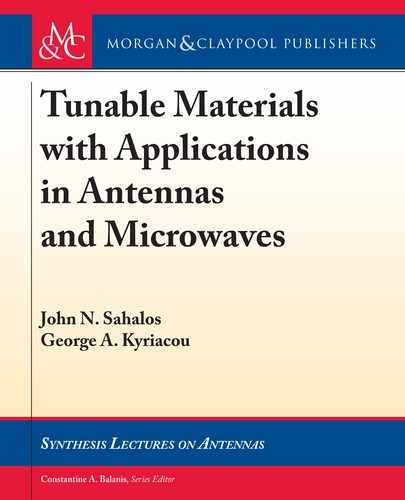
1
C H A P T E R 1
Ferrites and Ferroelectrics
1.1 TUNABLE ELECTROMAGNETIC MATERIALS
e potential usefulness of tunable electromagnetic materials has been recognized for at least 40
years [1, 2]. Since those early times, ferroelectric and ferrimagnetic materials (ferrites) in their
bulk form have been exploited in the implementation of tunable microwave devices. A variety of
famous devices, like circulators, phase shifters, and YIG (yttrium iron garnet) tuned oscillators,
contain magnetized bulk ferrites as their main part. Bulk ferroelectrics have not yet found their
way into widespread microwave applications. is is because ferroelectrics have higher losses
at room temperature than ferrites. ey also require large bias voltage. Nevertheless, electrical
control of ferroelectrics is considered easier than that of ferrites. In the last decade, microwave
applications of ferroelectrics have begun to emerge. is is mainly due to material technology
advancement, which tends to enhance ferroelectric properties.
e driving force behind the recent revived interest in ferrites and ferroelectrics is their
potential for substantial miniaturization of the components and systems in microwave (mw)
and millimeter wave (mmw) regions. In particular, the evolution of thin and thick film tech-
nology in ferrite/ferroelectric materials enables the integration of the above components with
microelectronic circuits. is is also accompanied by cost reduction. Cost, in turn, has a sig-
nificant impact on the growth of commercial wireless and defense-military systems. In order
to realize the importance of miniaturization, just recall that this was the key to the extraordi-
nary evolution of computer hardware and the whole information technology accompanying it.
Similarly, the miniaturization of radio frequency electronics underpins the dramatic progress
of wireless-mobile communication systems. In turn, miniaturization of mw-mmw circuits is
expected to carry the burden of the ever-increasing demand for bandwidth. is is important
because “broadband services for all,” especially in the fifth generation (5G), of wireless commu-
nications, are now in fashion and in great demand.
A question to be expected is how ferrites/ferroelectrics and, in general, tunable materials
are involved in the miniaturization game. Moreover, it is extremely useful to know how impor-
tant tunability in the advancement of mw and mmw electronics is. One of the key features in
the miniaturization of the above circuits is the reduction of their guided wavelength (
g
). is,
in turn, depends on the index of refraction (n) as
g
/ 1=nI n D
p
r
"
r
. us, a material with
a high dielectric constant "
r
and/or high relative permeability
r
serves this purpose. Ferrites
and composite-ferroelectrics offer high and tunable values of
r
and "
r
, respectively.
..................Content has been hidden....................
You can't read the all page of ebook, please click here login for view all page.
